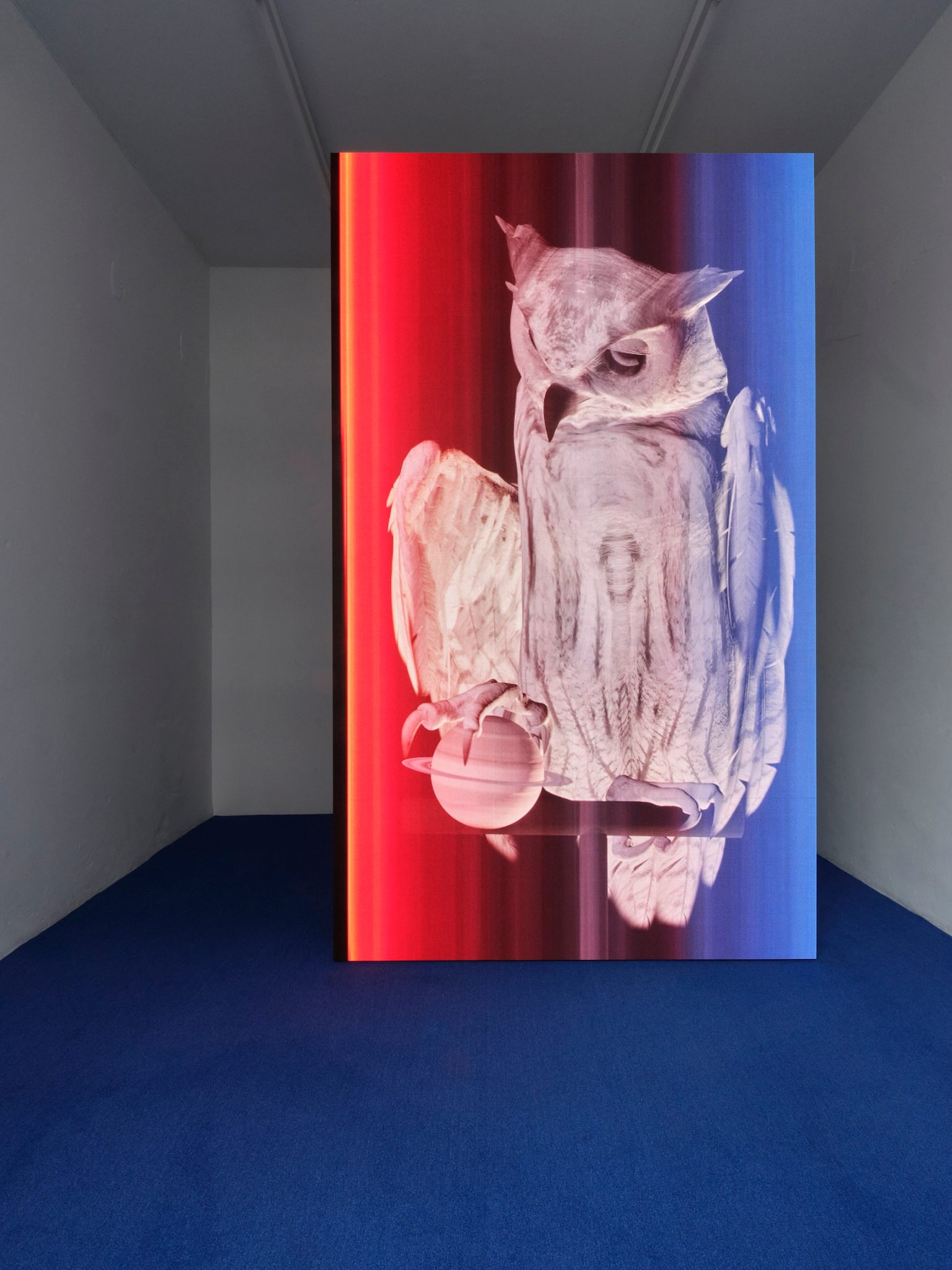
Ann Lislegaard, 'Oracles, Owls... Some Animals Never Sleep (Borealis),' 2021
Courtesy of the artist and palace enterprise
It wouldn’t be a stretch to call Ann Lislegaard ‘Scandinavia’s grand dame of feminist futurism’: the Norwegian-born, Copenhagen-based artist has interrogated our digital condition for over three decades, poetically guiding her audiences through numerous technological revolutions while offering salient critiques of each from the point of view of gender and embodiment.
Lislegaard’s art is committed to the most contemporary of issues— virtuality, robotics, climate change—and employs cutting-edge technology in the process; not to dazzle her audiences, but rather, to prompt critical reflections on the most foundational of questions relating to nature, consciousness, and what it means to be human.
Lislegaard’s works range from public monuments and single-channel videos to immersive installations that produce vertigo in the viewer by manipulating our sense of light and space. As such, they can be thought of as portals offering access to immersive worlds. These worlds are not crafted ex nihilo by the artist herself but respond directly to the so-called “SF genres”: string figures, science fact, science fiction, and speculative fabulation.
Authors J.G. Ballard and Samuel R. Delany are particular heroes, but the artist interweaves these male authorities of the genre with feminist critiques of technology as a culturally gendered sphere. Which subjects get to live and thrive in the speculative cyberfuture? Her most recent series Oracles, Owls…Some Animals Never Sleep (2021) lifted a motif from Philip K. Dick’s canonical sci-fi novel Do Androids Dream of Electric Sheep?, set in 2050, where the owl is the first species to go extinct due to irreparable human damage to the planet.
Lislegaard’s owl, however, has migrated permanently to the digital ether and become a cyborg: here, it is allowed to exist as an oracle-like entity of wisdom endowed with prophetic powers, in line with ancient Greek myth. The owl, however, seems visually unstable, like an automaton, and speaks in tongues. Only fragments can be deciphered and strung together stories about another future mass extinction event, that of machines. The oracle, Lislegaard reminds us, is also a trickster who rarely respects semiotic coherence and communicates primarily using allegory.

Ann Lislegaard, 'Extinction,' installation view
Courtesy of the artist and palace enterprise
The series is a celebration of the sci-fi genre as a space for speculation about our present, but it doubles, importantly, as a critique: why do we seem to depend so profoundly on far-fetched fictions to discuss apocalyptic scenarios that are, in fact, already unfolding in front of our very eyes? Which oracles will we finally take seriously and listen to; does art play a role in this messianic event, and if so, how?
In recent years, the urgency of planetary climate and ecosystemic collapse has steered Lislegaard away from more architectural and phenomenological interrogations of the virtual (consider her 3D animation Crystal World (after J. G. Ballard) from 2006).
Still, her long-time engagement with digital technology is evident in the precision of her contribution to the contemporary discourse that has become known as New Materialism. The artist shows us that when inverted, digital technologies can confront us with the virtuality of our most physical surroundings: our relationship to the environment and to our bodies.
1000år1000år (2022) realized in Horten, Norway is one of numerous recent public commissions by the artist, and replicates the local ancient oak tree Tordenskjoldeika in shimmering recycled aluminum with the help of 3D scanning.
At nearly a thousand years old, the tree has registered countless historic periods dating back to the Viking Age. As its own habitat for more than a thousand species of insects, fungi, mosses, and birds, it has also silently witnessed an increasingly accelerated process of species extinction in Norway.
Through the idiom of monumentality, Lislegaard proposes digital imaging as a potential archival technology for our impending ecosystemic collapse; a proposition that may seem gloomy, dystopian even, but is far from absurd in a time of mass extinction.

Ann Lislegaard, '1000år1000år,' 2022
Courtesy of the artist

Ann Lislegaard, '1000år1000år,' 2022
Courtesy of the artist

Ann Lislegaard, '1000år1000år,' 2022
Courtesy of the artist

Ann Lislegaard is internationally renowned for her visionary videos, animations, and sound-light installations that engage storytelling—specifically science fiction—to explore the malleability of human perception. The subversive potential of science fiction enables everyday scenarios to be framed by unusual rules. Rather than deconstructing categories of language or meaning, these categories are multiplied, transformed, and transfixed. In Lislegaard's work, experiences of simulated spheres are created by means of interdisciplinary hybrids and connections – between architecture and cinema, between fictional narratives, and between human beings, machines, and animals.
Ann Lislegaard is represented by palace enterprise.
Recent exhibitions by Lislegaard include: VERTIGO, ARoS, 2022, World Machine, Schlossmuseum, Linz, Austria, 2022, extinct, palace enterprise, 2021, Traces of Life, ARKEN, 2021, Fertile Ghosts, Kunstfort, Vijfhuizen, 2020. Lislegaard’s work can be found in the collections of: ARoS—Aarhus Kunstmuseum, Aarhus, Denmark, Louisiana Museum of Modern Art, Humlebæk, Denmark, The Solomon R. Guggenheim Museum, New York, NY, US among others.

Jeppe Ugelvig (b. 1993) is a curator, historian, and cultural critic based in California. He is a current Ph.D. candidate at UC Santa Cruz, where his research focuses on artistic responses to consumerism and product culture in the 20th century.
Jeppe’s criticism appears regularly in Artforum, frieze, and Spike Art Quarterly, where he serves as contributing editor. He has contributed texts to exhibition catalogues published by institutions such as MIT List Center, Pro Helvetia, the Hessel Museum, the MACRO, and Kunsthal Charlottenborg.
Jeppe has conducted curatorial residencies and research fellowships around the world, most recently at Fondazione Sandretto in Turin, Delfina Foundation in London, and MMCA in Seoul. Recent exhibitions include the ongoing research project “The Endless Garment” at X Museum (Beijing) and “Witch-Hunt” at Kunsthal Charlottenborg.




